7 Ways to Maintain Your Septic System
4/4/2016 (Permalink)
It is important to maintain your septic system for the health of your family, your community and for monetary reasons as well. Your septic system is an integral part of your household and the importance of it may not be fully realized until there is a problem. To prevent problems and major life inconveniences involving your septic system, there are a few simple procedures and rules to follow for its maintenance.
1) Regularly inspect your septic system. Get in touch with an On-Site System Maintainer to regularly inspect your system routine maintenance can save you a lot money in the long run.
2) Locate your septic system, take a picture of where it is in your yard and put it in a file. This will save a lot of time and aggravation later when you have to get your system pumped. You can also have risers installed to make the pumping and monitoring of your system easier and less time consuming.
3) Pump your system. Different systems call for different lengths of time between pumping and cleaning out your system. Typically your system should be pumped every 3-5 years. If there are a lot of people in your home or you use a lot of water, you may want to consider pumping your soon. Household amenities like garbage disposals, hot tubs and whirlpools can wreak havoc on your system so if these are present, shoot for every 2-3 years. It’s best to consult our septic system handbook, look it up online, or get the opinion of a professional for a more exact length of time between pumps.
4) Be water conscience. Fixing leaky faucets and running toilets immediately can prevent strain on your system. If these are not taken care of in a timely manner, your septic tank could overflow contaminating your yard, groundwater and the community in which you live. It’s also important to think before you flush! Only toilet paper should be flushed down the toilet. To prolong the life of your septic system avoid flushing items such as tampons, disposable diapers, cat litter, q-tips, condoms and anything other than toilet paper down the toilet and drain.
5) Proper landscaping can play a large part in the longevity of your septic system as well. Do not plant and shrubs or trees on top of your septic system. Their roots can grow and cause cracks in the system which can cost a lot of money down the road to replace. Never build anything above your system or pour a slab of concrete. It’s safest to just plan grass above the system and the drainfield to let it breathe and work properly.
6) Direct water from roof and land drains away from drainfield.
7) Add some yeast to keep the bacteria alive that breaks down solid waste. Flush a ½ cup of dry baking yeast down the toilet the first time and ¼ cup every 4 month after that.
Your septic system is an integral part of your household so do you part to take care of it for the health of your family, your community and your wallet!






 24/7 Emergency Service
24/7 Emergency Service

